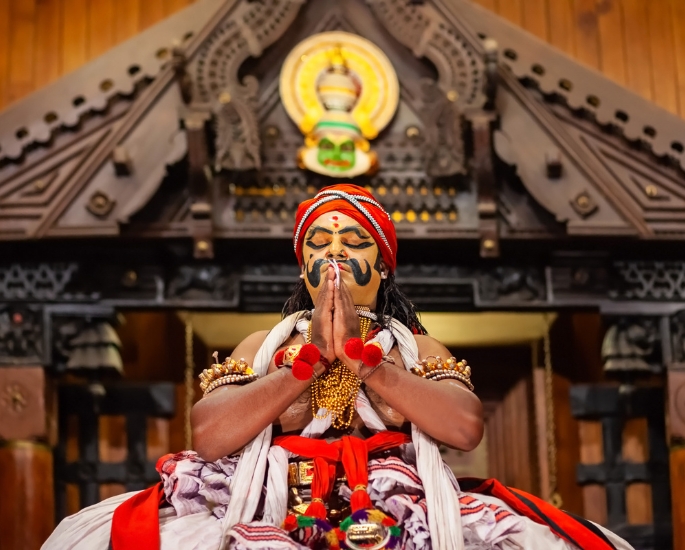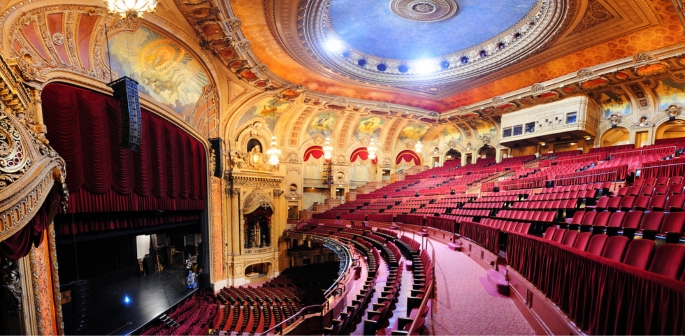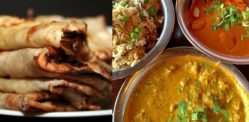After the independence in 1947, theatre struggled to survive.
Many influences have shaped how Pakistani and Indian theatres were established.
Not only this, but they also play different roles in society and communities.
Theatre serves as a space for escape, but it also addresses issues and brings certain ideologies and portrayals of truth to light.
Throughout the years, theatres have evolved in terms of their use and reception.
However, some traditions are preserved, with a clear emphasis on keeping these alive despite the outside influences that have shaped modern theatre.
The differences are highlighted below; some topics have stark differences, while others share similarities.
Motivations behind Theatre Productions

Yet, liberalism and free speech suffered due to the militancy policies initiated by Zia.
As a result, activists turned to private venues, as the movement denied permission for stages to present ideologies critical of the dictatorship.
This period saw a reaction against the military elite, with theatre activists using the medium to spotlight social and political issues.
The Movement for the Restoration of Democracy and the Women’s Action Forum staged performances in response to government policies.
“The Movement for the Restoration of Democracy (MRD), formed in 1983, aimed to pressure the dictatorial regime of Muhammad Zia-ul Haq into holding elections and suspending martial law.”
Moreover, the goals of the Women’s Action Forum included increasing women’s representation in parliament, raising awareness about family planning, and making public statements on women’s issues.
For example, ‘Dard Kay Faasley’ (Distances of Pain, 1981) by Tehrik-e-Niswan, is a play about the suffering of women in times of national bigotry and extremism.
Additionally, ‘Juloos/Procession’ (1984) by Ajoka, portrays the lifestyles of men in large cities and alludes to certain social issues.
Political theatre became a practice where political agendas were questioned and analysed, contributing to the cultivation of a social revolution.
Pakistani theatre offers insight into the dominant cultural, social, and political values the country holds, influencing viewers with thought-provoking and insightful ideas.
There was a sense of oppositional culture replacing the dominant cultures, particularly in the 80s.
In comparison, Indian theatre draws upon influences from Aristotle’s poetics.
The aesthetic theory of rasa influences the appearance of theatre, which includes philosophy and the addition of Sanskrit drama written by prominent playwrights like Bhasa, Kalidasa, Shudraka, Vishakadatta, Bhavabhuti, and Harsha during the first century.
The metropolitan middle and working classes were the target audiences, amused by the social commentary and melodrama of daily life portrayed in plays.
Plays served not only as a function of drama but also offered a critique of life.
In the 19th century, Indian theatre emerged as a massive source of entertainment in newly emerging metropolitan towns like Kolkata, Delhi, Mumbai, and Chennai.
The experiments of the IPTA (Indian People’s Theatre Association) were associated with socialist realism, committed to the idea that theatre can be used for social change.
In South India, theatre harmonised traditional forms with social messages, using age-old methods for contemporary productions.
There is a balance of Western and Indian stylistic aspects of theatre, with ideologies from different cultures.
Post-independence, Indian theatre has undergone many incarnations, supported by the state.
Playwrights delve into the modern angst of daily life, while younger writers tackle issues regarding identity and globalisation.
Pakistani theatre focuses on political change and oppression, whereas Indian theatre emphasises social aspects and messages to the audience.
There is a broader sense of freedom in Indian theatre, appealing to a wider audience, not just the elite as in Pakistan.
Indian theatre offers more creativity and innovation, as opposed to Pakistani theatre, which is more limited and censored.
Pakistani theatre faces more challenges in terms of women’s participation, while Indian theatre appears to be progressive and inclusive.
Core Components of Shows

Punjab’s tradition of theatre incorporates tragedy, mimes, musical operas, and more.
According to the University of Punjab, “folk theatre in the form of tamasha, swing, and nautanki has been practised in rural Punjab, while Dastangoi (storytelling) and puppetry have also been established forms.”
Moreover, storytelling combines singing and instrumental music.
Through voice and expression, storytellers give ancient tales a modern spin.
In folk stories, traditional folk rhythms are integral to their musical narratives.
A key component of Pakistani theatre is improvisation and ad-libbing.
Actors often perform in shows without a scripted script, relying on their creativity.
Commonly, comedians conducting one-man shows dominate popular Punjabi theatre.
For instance, Amanullah Khan, a performer, emerged as an icon of improvisational and superfluous ad-lib theatre.
Amanullah’s success mirrors that of Punjabi cinema star Sultan Rahi.
Iconic performances often feature Westernised influences, particularly in staging and costumes.
Occasionally, Pakistani theatre introduces new ideologies derived from the West, alongside traditional themes and characterisations.
Theatre includes Juggat, a Punjabi word meaning any word, phrase, or sentence that creates a pun.
“Third Theatre” emphasises minimal lighting, costumes, and props, focusing on physical movements over dialogue delivery.
Key components also include blocking, place of action, and mise-en-scène to engage the audience, along with long-acting focusing on dialogue delivery, voice control, and poise in movement.
According to writer and director Amy Aniobi, Mise-en-Scène is “the composition; how the story can be told by what you see, whether immediately or revealing it partway through or at the end of a scene.
“It’s how you tell the story by what you see and not what’s being said.”
In comparison, Indian theatre emphasises live performance, with a focus on time and space.
A profound underlying theme is that drama was a gift from the Gods to humans, according to the Natyashastra of Bharata.
These texts delve into philosophy and the essence of human behaviour.
Theatrical traditions include musicians, dancers, and singers, encompassing traditional folk and classical forms.
Ideas such as archaic rituals have been featured in Indian theatre for several centuries.
There are three distinct types of Indian theatre, each with different components: the classical period, the traditional period, and the modern period.
The classical period prioritises tradition. Margi is a subcategory of classical theatre.
Sanskrit theatre, performed at religious occasions in temples and festivals, addresses a certain status quo model of ideal human behaviour.
Every play aims to impact the audience, as rasa creates a beautiful connection between the actor and the audience.
At the beginning of the 15th century, theatre in certain vernacular languages catered to the needs of village people.
Natyashastra has profoundly influenced certain regions.
A noticeable difference is that Pakistani theatre focuses on folklore, whereas Indian theatre places a large emphasis on celebrating tradition, such as festivals and temples.
The groups represented in theatre differ; Indian theatre caters to village people, in contrast to Pakistani theatre’s specific appeal to Punjab.
Another difference is that Indian theatre focuses on physical movement, whereas Pakistani theatre emphasises improvisation and ad-libbing.
Challenges

One reason is rooted in the political ideologies of the country, where there was a clash between the newly established Muslim state and the remnants of Hindu influence.
Many aspects of Hindu traditions apparent in the arts were rejected by policymakers, affecting arts, crafts, and cultural formations that overlapped.
A challenge arose as Western theatre began influencing Pakistani theatre in terms of content and adaptations, leading to a division between the two types of theatre.
As a result, it failed to capture the attention of the middle and lower-middle classes, though it remained popular with the elite.
Juggat, based on folk tradition, began to unravel, leading to a divide between the aristocracy, which leaned towards Western culture, and the uneducated, who focused more on indigenous art.
Cinema began to occupy the space of the theatre, used by authorities to portray national agendas on screen.
Colonial rulers favoured cinema over theatre, using it as a form of centralised control.
Consequently, theatre halls were converted into cinema halls, making theatre a niche form of entertainment with performances now taking place in small local theatres.
There is also a degree of prejudice against women in theatre, with some families viewing women’s participation as undignified.
Other challenges include a lack of originality, with audiences unable to relate to productions that often repeat plots, stories, and motifs.
Moreover, the standard of these productions was poor compared to Western and Indian counterparts, lacking elegance and refinement.
Theatre has shifted its focus from artistic expression and individuality to financial gain, leading to a decline in creativity and a shift towards being a money-making venture.
Finally, an issue is the representation of Pakistanis in theatre.
Despite Pakistan being a melting pot of diverse cultures, theatre does not inclusively represent cultural traditions and societal insights.
In comparison, Indian theatre faces the challenge of contemporary theatre’s decline as its formats became overly westernised, distancing it from being recognised as authentically Indian.
Indian playwrights have struggled to find authentic and accurate roots in theatre, with Shreeja Narayanan noting the difficulty in determining the origins of Indian theatre.
The translation of English plays did not resonate as well as Western theatre, with playwrights focusing mainly on folk theatre due to this disconnect.
The growth of Indian English drama presented another problem, as English, spoken fluently by only a small fraction of the elite, appeals to a sophisticated society.
Technology, similar to Pakistan, offers a wider range of entertainment options, overshadowing theatre.
The depiction of stories is caught in a clash between the cultural and traditional pasts of the country, with playwrights needing to attract Western ideas while incorporating tradition.
In places like Karnataka, professional theatre survives but is not mainstream.
In Maharashtra, professional theatre interacts with elitist theatre, while in Assam and Kerala, professional theatre has not seen significant change.
Some theatres are only accessible through educational systems, seminars, and symposiums, with the distance between rural and urban populations, lack of sponsorship, and availability of stage spaces continuing to challenge Indian theatre.
Hindi theatre in the 1960s suffered from a lack of rehearsal space, advertisement, and script choice, with playwrights like Girish Karnad, Vijay Tendulkar, and Badal Sircar operating modestly to present contemporary plays.
A major failure of translation was that most readers could not access the script in its original or Hindi version.
One difference is that while Pakistani theatre faces criticism for women’s association with theatre, Indian theatre’s larger concern is the westernisation of its content.
In Pakistani theatre, there is a clash of Hindu and Muslim elements in productions, whereas in Indian theatre, the clash is more internal, between classes and their reception of theatre.
Similarly, both theatres face the challenge of entertainment shifting from theatre to cinema.
Characters and Themes

It showcases his humble beginnings as a Sufi poet named Bulleh Shah (1680 – 1759), who was persecuted by the clerics and rulers of Kasur.
The production features live qawwali and dhama, a devotional dance, representing a time of disintegration of the Mughal Empire.
The play presents rebellions, civil, and religious strife through internecine conflicts, political chaos, and Bulleh Shah as an advocate for hope and humanitarian equality.
His voice, resonating with love and tolerance, contrasts with the bigotry and hatred of the larger population.
‘Bullha’ is a tribute to him, based on his life events communicated through his poetry, acting as a lesson for present-day Pakistan and strongly influencing his search for truth in a world of opposition and wars.
Another play, ‘Hotel Mohenjodaro,’ portrays Pakistan overtaken by mullahs in search of power, where music, entertainment, and modern dresses are suddenly banned in the name of Islam.
The head of state, the ameer, is chosen without elections, leading to the killings of religious leaders and creating anarchy.
Shahid Nadeem adapted this story into a play.
‘Uddanhare,’ central to the partition of India and Pakistan in 1947, is based on interviews with the Citizens Archive of Pakistan.
It includes eyewitness accounts of events in East Punjab in 1947, addressing the situation of minority communities during significant power shifts in Pakistan and delving into the evil forces affecting the peace of the land.
According to the Ajoka Institute, the story of young Akhlaq and his friend Haleema is interwoven with the enduring love of two pigeons, Raja and Rani, portraying not just hate and violence but also noble human values of hope, peace, and humanity.
In contrast, Indian theatre features the stunning play ‘Andha Yug,’ written by Dharamvir Bharati in 1953.
It delves into the Kurukshetra war, portraying its horrors and raising relevant questions on the eternal riddle of good vs. evil.
The play revolves around Gandhari, who, unable to understand divine justice in losing all 100 of her people, curses Krishna, leading to a chilling narrative that acts as a prelude to the aftermath of Hiroshima’s Brahmastra.
‘Ghalib in New Delhi,’ written by M. Sayeed Alam, humorously captures the essence of the national capital through the journey of the 19th-century Urdu and Persian poet Mirza Ghalib, highlighting his wit and wisdom regarding modern society.
Finally, ‘Gagan Damama Bajyo,’ by Piyush Mishra, demonstrates the life of freedom fighter Shaheed Bhagat Singh, offering a different perspective on India’s fight for freedom of speech.
In Indian theatre, common themes are related to injustice, whereas Pakistani theatre largely focuses on societal conflicts.
However, both theatres address war, silence, and the ensuing struggles, drawing upon history to provide insight into their countries’ backgrounds.
Purpose of Theatres

These include secularism, democracy, and egalitarian issues within Pakistan, to promote quality.
The institute strives to merge traditional forms with modern techniques, all while fostering awareness through entertainment that serves a social purpose.
A key focus is on promoting peace through innovative productions and their underlying messages.
Similarly, the Lahore-based Alhamra Art Centre seeks to transform the city’s cultural landscape.
It tackles themes such as the 1947 partition, the Cold War, the Non-Aligned Movement, and various forms of domination, aiming to bring these significant topics to the forefront.
Artists like Seema Nursrat explore issues of policing and urbanisation from the 1970s to the present, while also paying homage to Urdu literature and addressing specific societal boundaries.
In contrast, Indian theatre, exemplified by Jatra Bengal—a renowned folk theatre in India and Bangladesh—aims to weave Hindu mythology and popular folklore into its productions, particularly highlighting these elements.
Performers make political statements about the early 20th century, with the original purpose of showcasing dancing processions in temple courtyards in the 15th century.
Prithvi Theatre, another cornerstone of Indian theatre, is dedicated to promoting performing and fine arts.
Since its establishment in 1975, the trust has aimed to:
- Promote professional theatre, especially Hindi Theatre, by providing a well-equipped theatre space at reasonable costs.
- Subsidise and support aspiring and deserving stage artists, technicians, researchers, etc.
- Offer medical and educational assistance to theatre workers and their children.
A notable distinction is that Pakistani theatre seeks to create social change, while Indian theatre focuses on educating audiences about Hindu mythology and culture.
Pakistani theatre is progressive, embracing modernisation and contemporary influences, whereas Indian theatre aims to remain relevant to current times.
Despite their differences in inspirations, influences, and content—with Pakistani theatre experiencing a decline and Indian theatre thriving—both forms represent ideologies and truths drawn from personal experiences through acting interpretations and stage production choices.
Productions may highlight past injustices, such as wars and real-life stories, but it’s crucial to recognise that perceptions will vary based on individual experiences.
Thus, while some aspects may resonate with one generation, they may not with another, underscoring the diverse impact of theatre across different audiences.





























































